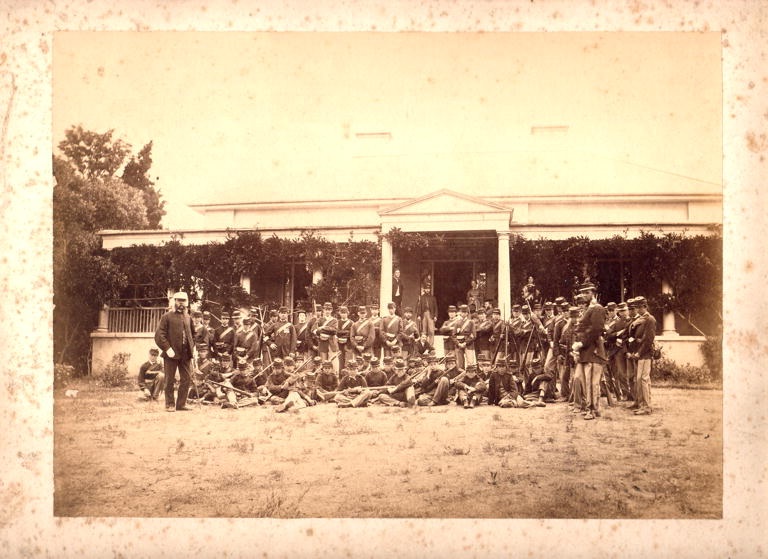Meehan, James
James Meehan (1174- 1826)
Born in Cooldery, Ireland in 1774, James was transported for a minor offence involving the Irish rebellion of 1798, possibly even leaving a wife a children behind. A petition by Meehan in 1799 describes himself as a ‘Schoolmaster and surveyor’. He also asserts that he was a sergeant with the United Irishmen.
In 1800 James arrived in Sydney aboard the Friendship. His experience as a surveyor was used by the Acting Surveyor General, Charles Grimes. With a heavy workload Grimes soon fell ill leaving his assistant Meehan to do much of the work. In 1803 Grimes recovered but left for England leaving Meehan the only qualified surveyor in the colony for the next three years.
From 1803 to 1820 Meehan marked not only farms but roads, rivers and creeks, much of it in harsh rugged country where he became as much an explorer as experienced surveyor. He also marked towns, churches and burial grounds.
1805 saw Meehan surveying the track used by John Warby between Prospect and Cowpastures. He also marked out 5000 acres for John Macarthur at Camden Park. It was during this year he gained a conditional pardon and upon the return of Grimes an absolute Pardon.
Meehan was granted 340 acres of land in the district of Minto in 1809. He was to have called it Thomas Town after his only son but the grant was withdrawn after a review by Macquarie. In 1810, however, Macquarie did grant Meehan 1140 acres to be known by the name ‘Macquarie Field’
An official public notice in the Sydney Gazette of 1811 asks all persons who have been promised lands in the districts of Minto, Airds or Appin to meet the acting-surveyor, at Mr Robert Campbell’s stockyard and to bring blankets and 10-12 days provisions ‘to enable them to remain out with the surveyor for as long as may be necessary.’
James Meehan very nearly became the Surveyor-General in 1812, recommended by Macquarie himself but John Oxley, a naval officer, petitioned the British government persistently from the very day Grimes resigned and won the post much to Meehan’s and Macquarie’s disappointment.
Meehan mortgaged Macquarie field to the bank of NSW in 1819 for £500.
In 1820 James Meehan was asked by Macquarie if he would let his Macquarie Field house to be used as an academy for the upper-class youth of the colony, it was to be conducted by Rev Thomas Reddall. Meehan agreed so long as he could keep two rooms for himself.

Macquarie Field House in 1866 when it was home to the Cadet corps
In 1824 a plot was hatched by convicts and bushrangers to liberate the convicts. To achieve this end they intended to rob various properties in the area and outfit themselves with equipment including a compass, quadrant and some guns. They felt sure they could find the navigational tools at Meehan’s house. When the plotters arrived they found the window locked and they went no further.
On the way back along Campbelltown Road a man named Leach met one of the plotters and told him ‘not to have anything to do with Mr Meehan’s property for if they did he could soon overtake them - being so well acquainted with the bush.’
James had children by Ruth Goodair. His son, Thomas was born in 1808 and a daughter, Mary in 1810 though sadly she died in 1823.
Macquarie wrote of Meehan in 1817, ‘there is not a more useful officer serving under this Government, being particularly well qualified for the office of Deputy Surveyor General from his perfect knowledge in that particular line, his local and extensive knowledge of every part of this Territory and his intimate acquaintance with the history and cause of every grant or lease ever made in the colony since its first establishment.”
The strain of his work took its toll and in 1821 and Meehan tendered his resignation though it was not accepted till the following year.
He died at Macquarie Field on the 21 of April 1826. His Macquarie Fields estate was now 2400 acres with several tenants farming the land. Thomas, his eighteen year old son, inherited the property. Until his 21st birthday it was to be managed by Charles Throsby and William Redfern the trustee and neighbour. Unfortunately, Throsby commited suicide and Redfern went overseas. When Thomas Meehan finally came into his inheritance there were only debts and he was forced to sell Macquarie Fields in 1831. The stress broke young Mary Ann, Thomas’ wife of two years, who was committed to Liverpool Asylum from 1831 until her death in 1876.
Thomas Meehan served briefly as postmaster at Campbelltown and died in 1835, aged 27, leaving two infant daughters.
Bibliography
James Meehan and the Macquarie Field Estate
Grist Mills: Journal of the Campbelltown and Airds historical Society Inc Vol 15 No 1 March 2002. By Verlie Fowler
Australian Encyclopedia, Australian Geographic. Vol 5 p2056